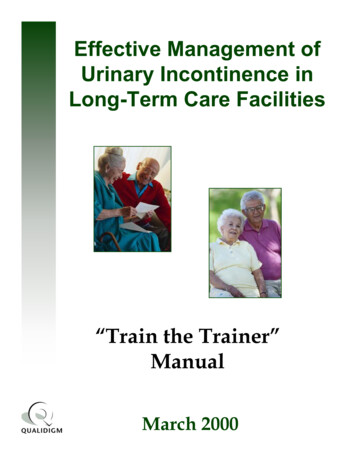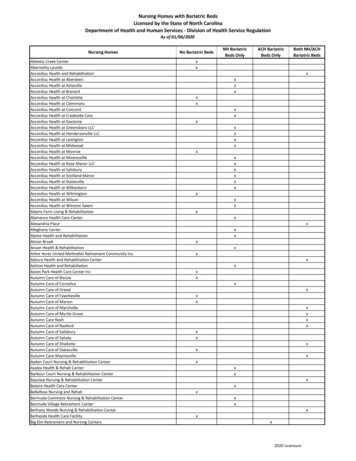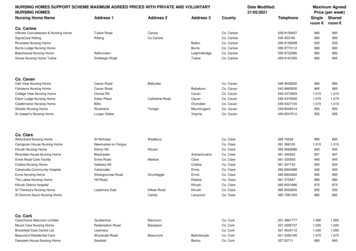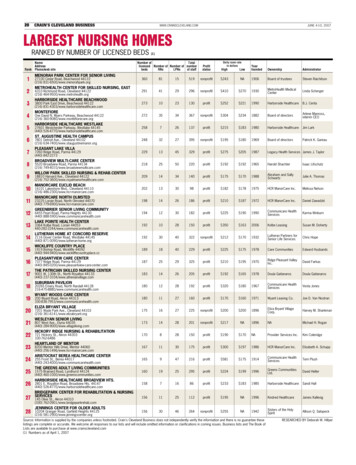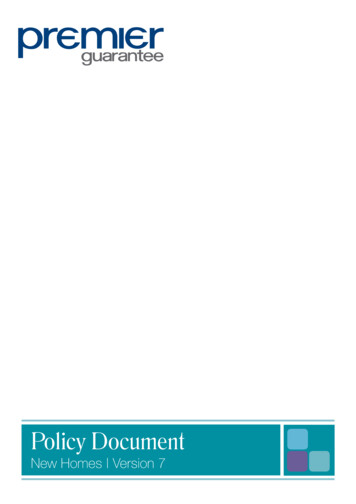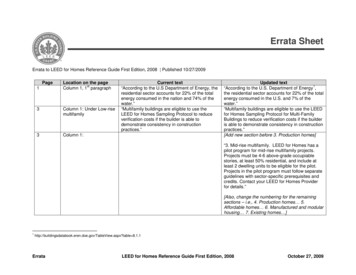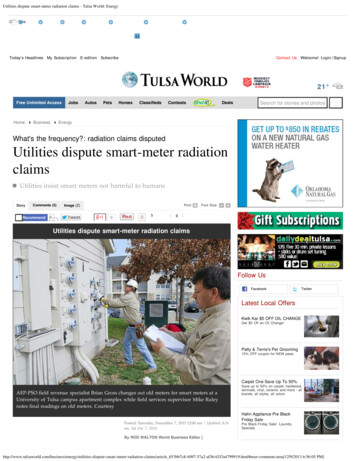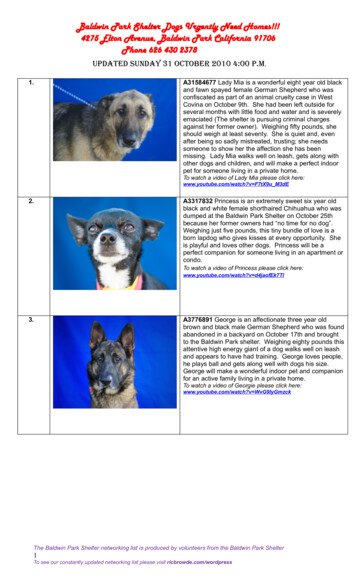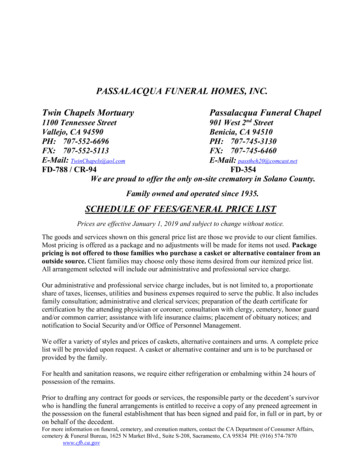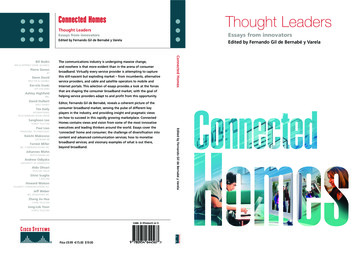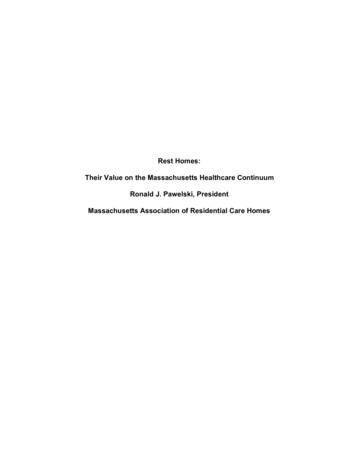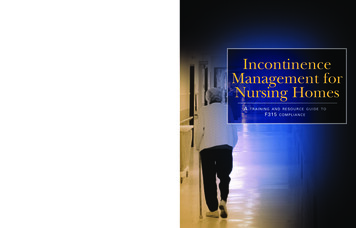
Transcription
IncontinenceManagement forNursing HomesAtraining and resource guide toF315compliance
Section 1F315: Urinary Incontinence(from the Centers for Medicare & Medicaid Services)§483.25(d) Urinary Incontinence(Rev.8, Issued: 06-28-05, Effective: 06-28-05, Implementation: 06-28-05)Based on the resident’s comprehensive assessment, the facility must ensure that —Interpretive Guidance §483.25(d) Are universal precautions used during all wound care? (See §483.65, InfectionControl. Have the care plan objectives been evaluated? If the pressure sore is not healing, getting larger, or signs of additional skin breakdown are evident, have alternative interventions been considered or attempted? Has improvement been noted?F315§483.25(d) (1) A resident who enters the facility without an indwelling catheter is notcatheterized unless the resident’s clinical condition demonstrates that catheterizationwas necessary; and§483.25(d) (2) A resident who is incontinent of bladder receives appropriate treatmentand services to prevent urinary tract infections and to restore as much normal bladderfunction as possible.INTENT: (F315) 42 CFR 483.25 (d) (1) and (2) Urinary Incontinence and CathetersThe intent of this requirement is to ensure that:Incontinence Management for Nursing Homes: A training and resource guide to F-315 compliance1
Section 1 Each resident who is incontinent of urine is identified, assessed and provided appropriate treatment and services to achieve or maintain as much normal urinary functionas possible;– An indwelling catheter is not used unless there is valid medical justification;– An indwelling catheter for which continuing use is not medically justified is discontinued as soon as clinically warranted;– Services are provided to restore or improve normal bladder function to the extentpossible, after the removal of the catheter; and A resident, with or without a catheter, receives the appropriate care and services toprevent infections to the extent possible.DEFINITIONSDefinitions are provided to clarify clinical terms related to evaluation and treatment of urinary incontinence and catheter use. “Bacteremia” is the presence of bacteria in the bloodstream. “Bacteriuria” is defined as the presence of bacteria in the urine. “Urinary Incontinence” is the involuntary loss or leakage of urine. There are severaltypes of urinary incontinence, and the individual resident may experience more thanone type at a time. Some of the more common types include:– “Functional Incontinence” refers to loss of urine that occurs in residents whose urinary tract function is sufficiently intact that they should be able to maintain continence, but who cannot remain continent because of external factors (e.g., inabilityto utilize the toilet facilities in time);– “Mixed Incontinence” is the combination of stress incontinence and urge incontinence;– “Overflow Incontinence” is associated with leakage of small amounts of urinewhen the bladder has reached its maximum capacity and has become distended;– “Stress Incontinence” (outlet incompetence) is associated with impaired urethralclosure (malfunction of the urethral sphincter) which allows small amounts ofurine leakage when intra-abdominal pressure on the bladder is increased by sneezing, coughing, laughing, lifting, standing from a sitting position, climbing stairs, etc.;2Incontinence Management for Nursing Homes: A training and resource guide to F-315 compliance
F315: Urinary incontinence– “Transient Incontinence” refers to temporary episodes of urinary incontinencethat are reversible once the cause(s) of the episode(s) is (are) identified and treated;and– “Urge Incontinence” (overactive bladder) is associated with detrusor muscle overactivity (excessive contraction of the smooth muscle in the wall of the urinary bladder resulting in a sudden, strong urge (also known as urgency) to expel moderateto large amounts of urine before the bladder is full). “Urinary Retention” is the inability to completely empty the urinary bladder by micturition. “Urinary Tract Infection” (UTI) is a clinically detectable condition associated withinvasion by disease causing microorganisms of some part of the urinary tract, including the urethra (urethritis), bladder (cystitis), ureters (ureteritis), and/or kidney(pyelonephritis). An infection of the urethra or bladder is classified as a lower tractUTI and infection involving the ureter or kidney is classified as an upper tract UTI. “Urosepsis” refers to the systemic inflammatory response to infection (sepsis) thatappears to originate from a urinary tract source. It may present with symptoms suchas fever, hypotension, reduced urine output, or acute change in mental status.OVERVIEWUrinary incontinence is not normal. Although aging affects the urinary tract and increasesthe potential for urinary incontinence, urinary incontinence is not a normal part of aging.In the younger person, urinary incontinence may result from a single cause. In the olderindividual, urinary incontinence generally involves psychological, physiological, pharmacological and/or pathological factors or co-morbid conditions (e.g., later stages of dementia, diabetes, prostatectomy, medical conditions involving dysfunction of the centralnervous system, urinary tract infections, etc.). Because urinary incontinence is a symptomof a condition and may be reversible, it is important to understand the causes and toaddress incontinence to the extent possible. If the underlying condition is not reversible, itis important to treat or manage the incontinence to try to reduce complications.Incontinence Management for Nursing Homes: A training and resource guide to F-315 compliance3
Section 1Many older adults are incontinent of urine prior to admission to a nursing home. Urinaryincontinence and related loss of independence are prominent reasons for a nursing homeadmission. Articles1 and data currently available, including CMS data (e.g., MDS ActiveResident Information Report (Item H1b) at www.cms.hhs.gov/states/mdsreports), indicatethat more than 50% of the nursing home population experience some degree of urinaryincontinence. Whether the resident is incontinent of urine on admission or developsincontinence after admission, the steps of assessment, monitoring, reviewing, and revisingapproaches to care (as needed) are essential to managing urinary incontinence and torestoring as much normal bladder function as possible.Various conditions or situations may aggravate the severity of urinary incontinence innursing home residents. In addition, urinary incontinence may be associated with changesin skin integrity, skin irritation or breakdown, urinary tract infections, falls and fractures,sleep disturbances, and psychosocial complications including social withdrawal, embarrassment, loss of dignity, feelings of isolation, and interference with participation in activities.Various factors common to elderly individuals may increase the risk of infection including:underlying diseases (e.g., diabetes mellitus), medications that affect immune responses toinfection (e.g., steroids and chemotherapy, history of multiple antibiotic usage), conditionsthat cause incontinence, and indwelling urinary catheters.The urinary tract is a common source of bacteremia in nursing home residents. Urinarytract infection (UTI) is one of the most common infections occurring in nursing homesand is often related to an indwelling urinary catheter. Without a valid clinical rationale foran indwelling catheter, its use is not an acceptable approach to manage urinary incontinence. Although UTIs can result from the resident’s own flora, they may also be the resultof microorganisms transmitted by staff when handling the urinary catheter drainage system and/or providing incontinence care. Hand washing remains one of the most effectiveinfection control tools available.ResourcesIt is important for the facility to have in place systems/procedures to assure: assessments aretimely and appropriate; interventions are defined, implemented, monitored, and revised asappropriate in accordance with current standards of practice; and changes in condition are4Incontinence Management for Nursing Homes: A training and resource guide to F-315 compliance
F315: Urinary incontinencerecognized, evaluated, reported to the practitioner, and addressed. The medical director andthe quality assessment and assurance committee may help the facility evaluate existingstrategies for identifying and managing incontinence, catheter use, and UTIs, and ensure thatfacility policies and procedures are consistent with current standards of practice.Research into appropriate practices to prevent, manage, and treat urinary incontinence,urinary catheterization, and UTI continues to evolve. Many recognized clinical resourceson the prevention and management of urinary incontinence, infection, and urinarycatheterization exist. Some of these resources include: The American Medical Directors Association (AMDA) at www.amda.com (ClinicalPractice Guidelines: Clinical Practice Guidelines, 1996); The Quality Improvement Organizations, Medicare Quality ImprovementCommunity Initiatives at www.medqic.org; The CMS Sharing Innovations in Quality website at www.cms.hhs.gov/medicaid/surveycert/siqhome.asp; Association for Professionals in Infection Control and Epidemiology (APIC) atwww.apic.org; Centers for Disease Control at www.cdc.gov; The Annals of Long Term Care publications at www.mmhc.com; American Foundation for Urologic Disease, Inc. at www.afud.org; and The American Geriatrics Society at www.americangeriatrics.org.NOTE: References to non-CMS sources or sites on the internet are provided as a service and do not constitute or imply endorsement of these organizations or their programs by CMS or the U. S. Department of Health and Human Services. CMS is notresponsible for the content of pages found at these sites. URL addresses were currentas of the date of this publication.Incontinence Management for Nursing Homes: A training and resource guide to F-315 compliance5
Section 1Resident ChoiceIn the course of developing and implementing care plan interventions for treatment andservices related to achieving the highest practicable level of urinary continence, preventingand treating urinary tract infections, and avoiding the use of indwelling catheters withoutmedical justification, it is important to involve the resident and/or her or his surrogate incare decisions and to consider whether the resident has an advance directive in place.In order for a resident to exercise his or her right appropriately to make informed choicesabout care and treatment or to refuse treatment, the facility and the resident (or the resident’s legal representative) must discuss the resident’s condition, treatment options,expected outcomes, and consequences of refusing treatment. The facility should addressthe resident’s concerns and offer relevant alternatives, if the resident has refused specifictreatments. (See Resident Rights 483.10(b) (3) and (4) (F154 and F155).)Advance Directive. A resident who is at the end of life or in terminal stages of an illnessor who has multiple organ system failures may have written directions for his or her treatment goals (or a decision has been made by the resident’s surrogate or representative, inaccordance with State law).Although a facility’s care must reflect a resident’s wishes as expressed in the Directive, inaccordance with State law, the presence of an Advance Directive does not absolve thefacility from giving supportive and other pertinent care that is not prohibited by theAdvance Directive. The presence of a “Do Not Resuscitate” (DNR) order does not indicatethat the resident is declining appropriate treatment and services. It only indicates that theresident should not be resuscitated if respirations and/or cardiac function cease.If the facility has implemented individualized approaches for end-of-life care in accordance with the resident’s wishes, and has implemented appropriate efforts to try to stabilize the resident’s condition (or indicated why the condition cannot or should not bestabilized), and has provided care based on the assessed needs of the resident, then thedevelopment, continuation, or progression of urinary incontinence; the insertion andprolonged use of an indwelling urinary catheter; the development of infection or skinrelated complications from urine or an indwelling catheter may be consistent with regulatory requirements.6Incontinence Management for Nursing Homes: A training and resource guide to F-315 compliance
F315: Urinary incontinenceURINARY INCONTINENCE42 CFR 483.25 (d) (2) Urinary Incontinence requires that a resident who is incontinent ofbladder receives appropriate treatment and services to prevent urinary tract infections andto restore as much normal bladder function as possible.Urinary incontinence generally involves a number of transitory or chronic progressive factors that affect the bladder and/or the urethral sphincter. Any condition, medication, orfactor that affects lower urinary tract function, bladder capacity, urination, or the ability totoilet can predispose residents to urinary incontinence and may contribute to incompletebladder emptying.The first steps toward assuring that a resident receives appropriate treatment and services to restore as much bladder function as possible or to treat and manage the incontinence are to identify the resident already experiencing some level of incontinence or atrisk of developing urinary incontinence and to complete an accurate, thorough assessment of factors that may predispose the resident to having urinary incontinence. This isfollowed by implementing appropriate, individualized interventions that address theincontinence, including the resident’s capabilities and underlying factors that can beremoved, modified, or stabilized, and by monitoring the effectiveness of the interventions and modifying t
incontinence after admission, the steps of assessment, monitoring, reviewing, and revising approaches to care (as needed) are essential to managing urinary incontinence and to restoring as much normal bladder function as possible. Various conditions or situations may aggravate the severity of urinary incontinence in nursing home residents. In addition, urinary incontinence may be associated File Size: 331KBPage Count: 45
